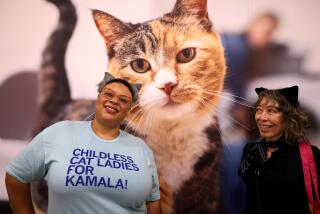A New Fat Cat Destined for the Oval Office
- Share via
Why is this cat smiling?
To understand, you have to know where he has been and where he may go.
“Socks” (the painting), was created in 1993 by Michele Weston Relkin of Thousand Oaks. She is a cat fancier, artist and children’s art teacher who noticed that when Chelsea Clinton moved into the White House she was almost always photographed carrying her beloved cat.
“I wanted to ease her path a bit, growing up in that difficult environment. I decided to give her a portrait of Socks.”
For months Relkin collected news photos of the first feline, and eventually finished what she hoped was a reasonably accurate likeness. (“Were his front paws really white? How far up did the white go?”)
She framed the canvas ornately, in ebony and gold--suitable for White House hanging, she hoped.
By now, she was determined to deliver the picture and meet the real-life Socks.
But how? A quick call to a neighborhood newspaper produced unintended results. The cat-ricature wound up on Page 1. Still, nobody knew how to get the canvas into the White House.
Relkin opted to stop thinking about it for a while.
Her phone rang a few weeks later. It was not the Clinton administration, but close. A curator from the Ronald Reagan Library who had seen the newspaper picture wanted to see the real thing.
“I brought it there; they loved it and asked to put it in an exhibit of gifts to presidents, from George Washington to Bill Clinton. It would be on view for about a year, they said. Yes, but this cat was meant for Chelsea in the White House,” Relkin lamented.
“Don’t worry. If you let us exhibit it, we promise to get it there.”
The deal was struck.
So “Socks” (the painting) was placed on an “impressive, specially designed easel, which sat right in the middle of things” at the Reagan Library exhibit. Then, in 1994, it was shipped, as promised, to 1600 Pennsylvania Ave.
Relkin soon received “the warmest, friendliest thank you” from the Clintons--although no mention was made of where the portrait had been placed.
Was “Socks” really hanging in the White House, or was the canvas cat in a musty room among other presidential gifts. Relkin had no idea--and it would have been impolite to ask.
“I was happy it got there. I decided I’d probably never meet the real Socks, and I should let go of the idea.”
Not so fast. About two months ago, the White House called to ask if Relkin would permit them to ship the 18-by-24-inch acrylic-on-canvas cat to the Smithsonian Institution, for an exhibit titled “Tokens and Treasures: Gifts to 12 Presidents.”
“To get a call from the White House makes you feel really connected. Of course I said yes.”
Next, an elegant invitation arrived from the Smithsonian, inviting Relkin and family to a private reception inaugurating the show.
The artist, her airplane mechanic husband and 12-year-old son flew to Washington.
“The minute we touched down, I phoned the White House and asked if we could meet the real Socks. They said yes.”
At the Smithsonian reception, Relkin wept openly when she saw that her Socks portrait occupied the entire back cover of the exhibition cat-alogue.
Then off to the presidential palace. After being frisked and going through “immense security checks,” the Relkins were led to Socks’ private office.
Since they are among the few who’ve had an audience with the fat cat, we bring you highlights of Michele Relkin’s report:
Unlike most political animals, Socks disdains publicity. He apparently works long hours in a private office near the president’s, often perched on a 4-foot-high replica of a U.S. mailbox made of red, white and blue carpet. He has obvious influence in the administration, and a loyal staff that unquestioningly follows his lead. (The lead, incidentally, is of leather and attaches to a harness that Socks wears instead of a tie and collar.)
When the Relkins first arrived, Socks “was in this intense sleep, worn out from a full day of meeting and greeting foreign dignitaries.” His little black diplo-cat head was hanging out the front of the mailbox, his tail drooping out the rear. And his velvety white nose was a strange bright yellow, Relkin noticed. “It was pollen he’d collected while investigating the new flower arrivals.” And when Socks’ staff tried to rouse him by tipping the mailbox, he still refused to awaken. “We were invited back for the next day.”
The next day Socks was wide awake. The Relkins walked him in the garden, held and petted him. “He is black and white, looks like he’s wearing a tuxedo. He’s very elegant, with beautiful yellow eyes. It’s obvious he likes his work. When we walked back from the garden, he led us directly to his office at a brisk pace. He couldn’t wait to get back. I believe he’s a very happy cat.”
And why not? From humble beginnings in a rural Arkansas pound, he’s made it all the way to Top Cat of the U.S.A.
Relkin says she’s proud to have met him, and painted him. But her dreams of having the picture in the White House have been dashed: “I was informed that only pictures of dead individuals are permitted to hang there,” she says.
More to Read
The biggest entertainment stories
Get our big stories about Hollywood, film, television, music, arts, culture and more right in your inbox as soon as they publish.
You may occasionally receive promotional content from the Los Angeles Times.










